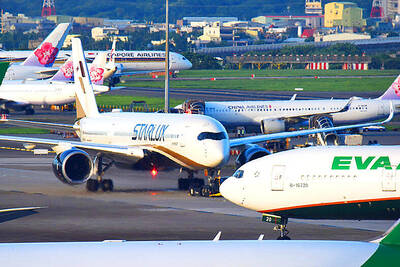The Atomic Energy Council (AEC) yesterday touted its preliminary success on Solor Oxide Fuel Cell(固態氧化燃料電池, SOFC) research and development, saying that with government support, it hoped to launch commercial models of the batteries for the consumer market by 2010.
“As the global trend in energy is to reduce greenhouse gas emissions and increase fuel efficiency, fuel cells are bound to be an important industry in the future, as they can be combined with clean coal technologies to produce efficient and green energy,” AEC Institute of Nuclear Energy Research (INER) fuel cell program manager Lee Chien-hsiung (李堅雄) said.
Fuel cells are a type of “battery” that employ electrochemical conversion to generate electricity, which can be used in a wide variety of applications including cars, retail stores and homes, Lee said, adding: “As fuel cells are showing a lot of promise for powering energy-demanding devices, the US government has made its research and development a flagship project.”
In Solid Oxide Fuel Cells, oxygen ions are transported through a thin layer of ceramic — which is used in the cells as electrolyte material — to react with fuels [such as natural gas, biofuel or diesel] and produce electricity through electrochemical reactions, Lee said.
The energy-efficiency of Solid Oxide Fuel Cells comes from the fact that unlike other types of fuel cells, such as proton exchange membrane fuel cells (PEMFC), ceramics are used as electrolyte materials, so they can withstand extremely high temperatures.
“This means that the thermal byproduct of Solid Oxide Fuel Cells can be used to increase their fuel efficiency,” Lee said.
While the cell units themselves can reach as much as 60 percent fuel efficiency, the heat produced as a byproduct can be used to fire a secondary gas turbine, the hybrid system. This is called a combined heat and power (CHP) system and can produce an impressive 90 percent total efficiency, he said.
“To give people an idea of fuel efficiencies today, car engines currently have about 10 percent to 17 percent fuel to electric efficiency,” he added.
Fixing their eyes on the great potential of the cells, the INER started their Solid Oxide Fuel Cell program in 2003, Lee said, adding that after five years of hard work, the institute had successfully produced a 10cm by 10cm anode-supported cell (ASC) and metal-supported cell (MSC) that is on a par with international standards.
“The cells that we have produced can generate 500mW of electricity per square centimeter under operating conditions of 800°C. When the cell units are stacked, more powerful systems can be created … This year, we successfully created a 1kW system at the institute, with a goal of manufacturing 1kW to 5 kW units for residential or retail storefront applications by 2010,” Lee said.
However, Lee also said that the recent success was only the first step in mass producing the cells.
As Solid Oxide Fuel Cells are still in the developmental stage worldwide, Taiwan needs to aggressively invest in the technology to become competitive in the potentially lucrative future market for the cells, he said.
“The government plays an important role in fuel cell development, as, if subsidies are given, research in the field would be more rapidly conducted, and commercial sales of the units would be more accepted, which in turn would bring the cost of the batteries down and promote better and better models to be made,” he said.

The disruption of 941 flights in and out of Taiwan due to China’s large-scale military exercises was no accident, but rather the result of a “quasi-blockade” used to simulate creating the air and sea routes needed for an amphibious landing, a military expert said. The disruptions occurred on Tuesday and lasted about 10 hours as China conducted live-fire drills in the Taiwan Strait. The Civil Aviation Administration (CAA) said the exercises affected 857 international flights and 84 domestic flights, affecting more than 100,000 travelers. Su Tzu-yun (蘇紫雲), a research fellow at the government-sponsored Institute for National Defense and Security Research, said the air

Taiwan is to commence mass production of the Tien Kung (天弓, “Sky Bow”) III, IV and V missiles by the second quarter of this year if the legislature approves the government’s NT$1.25 trillion (US$39.78 billion) special defense budget, an official said yesterday. Commenting on condition of anonymity, a defense official with knowledge of the matter said that the advanced systems are expected to provide crucial capabilities against ballistic and cruise missiles for the proposed “T-Dome,” an advanced, multi-layered air defense network. The Tien Kung III is an air defense missile with a maximum interception altitude of 35km. The Tien Kung IV and V

Trips for more than 100,000 international and domestic air travelers could be disrupted as China launches a military exercise around Taiwan today, Taiwan’s Civil Aviation Administration (CAA) said yesterday. The exercise could affect nearly 900 flights scheduled to enter the Taipei Flight Information Region (FIR) during the exercise window, it added. A notice issued by the Chinese Civil Aviation Administration showed there would be seven temporary zones around the Taiwan Strait which would be used for live-fire exercises, lasting from 8am to 6pm today. All aircraft are prohibited from entering during exercise, it says. Taipei FIR has 14 international air routes and

Taiwan lacks effective and cost-efficient armaments to intercept rockets, making the planned “T-Dome” interception system necessary, two experts said on Tuesday. The concerns were raised after China’s military fired two waves of rockets during live-fire drills around Taiwan on Tuesday, part of two-day exercises code-named “Justice Mission 2025.” The first wave involved 17 rockets launched at 9am from Pingtan in China’s Fujian Province, according to Lieutenant General Hsieh Jih-sheng (謝日升) of the Office of the Deputy Chief of the General Staff for Intelligence at the Ministry of National Defense. Those rockets landed 70 nautical miles (129.6km) northeast of Keelung without flying over Taiwan,